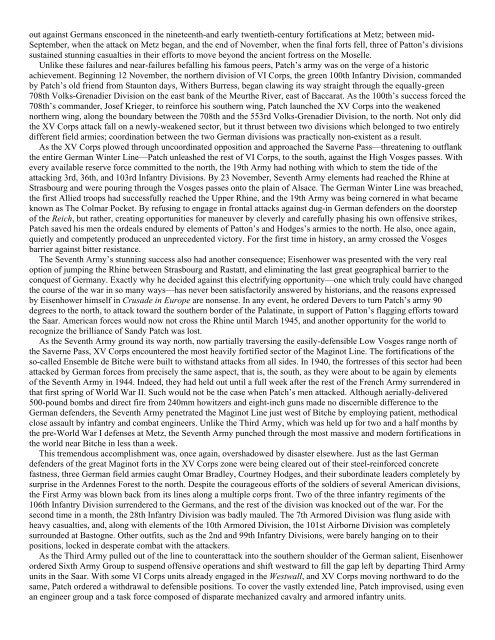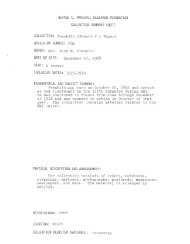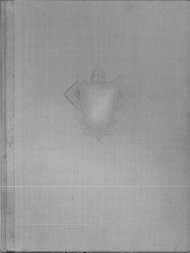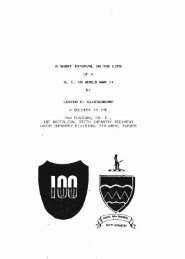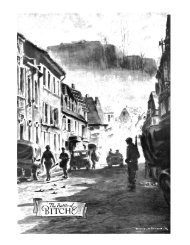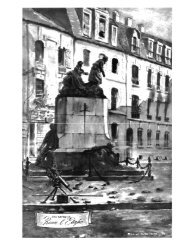Most Underrated General of World War II - The George C. Marshall ...
Most Underrated General of World War II - The George C. Marshall ...
Most Underrated General of World War II - The George C. Marshall ...
You also want an ePaper? Increase the reach of your titles
YUMPU automatically turns print PDFs into web optimized ePapers that Google loves.
out against Germans ensconced in the nineteenth-and early twentieth-century fortifications at Metz; between mid-<br />
September, when the attack on Metz began, and the end <strong>of</strong> November, when the final forts fell, three <strong>of</strong> Patton’s divisions<br />
sustained stunning casualties in their efforts to move beyond the ancient fortress on the Moselle.<br />
Unlike these failures and near-failures befalling his famous peers, Patch’s army was on the verge <strong>of</strong> a historic<br />
achievement. Beginning 12 November, the northern division <strong>of</strong> VI Corps, the green 100th Infantry Division, commanded<br />
by Patch’s old friend from Staunton days, Withers Burress, began clawing its way straight through the equally-green<br />
708th Volks-Grenadier Division on the east bank <strong>of</strong> the Meurthe River, east <strong>of</strong> Baccarat. As the 100th’s success forced the<br />
708th’s commander, Josef Krieger, to reinforce his southern wing, Patch launched the XV Corps into the weakened<br />
northern wing, along the boundary between the 708th and the 553rd Volks-Grenadier Division, to the north. Not only did<br />
the XV Corps attack fall on a newly-weakened sector, but it thrust between two divisions which belonged to two entirely<br />
different field armies; coordination between the two German divisions was practically non-existent as a result.<br />
As the XV Corps plowed through uncoordinated opposition and approached the Saverne Pass—threatening to outflank<br />
the entire German Winter Line—Patch unleashed the rest <strong>of</strong> VI Corps, to the south, against the High Vosges passes. With<br />
every available reserve force committed to the north, the 19th Army had nothing with which to stem the tide <strong>of</strong> the<br />
attacking 3rd, 36th, and 103rd Infantry Divisions. By 23 November, Seventh Army elements had reached the Rhine at<br />
Strasbourg and were pouring through the Vosges passes onto the plain <strong>of</strong> Alsace. <strong>The</strong> German Winter Line was breached,<br />
the first Allied troops had successfully reached the Upper Rhine, and the 19th Army was being cornered in what became<br />
known as <strong>The</strong> Colmar Pocket. By refusing to engage in frontal attacks against dug-in German defenders on the doorstep<br />
<strong>of</strong> the Reich, but rather, creating opportunities for maneuver by cleverly and carefully phasing his own <strong>of</strong>fensive strikes,<br />
Patch saved his men the ordeals endured by elements <strong>of</strong> Patton’s and Hodges’s armies to the north. He also, once again,<br />
quietly and competently produced an unprecedented victory. For the first time in history, an army crossed the Vosges<br />
barrier against bitter resistance.<br />
<strong>The</strong> Seventh Army’s stunning success also had another consequence; Eisenhower was presented with the very real<br />
option <strong>of</strong> jumping the Rhine between Strasbourg and Rastatt, and eliminating the last great geographical barrier to the<br />
conquest <strong>of</strong> Germany. Exactly why he decided against this electrifying opportunity—one which truly could have changed<br />
the course <strong>of</strong> the war in so many ways—has never been satisfactorily answered by historians, and the reasons expressed<br />
by Eisenhower himself in Crusade in Europe are nonsense. In any event, he ordered Devers to turn Patch’s army 90<br />
degrees to the north, to attack toward the southern border <strong>of</strong> the Palatinate, in support <strong>of</strong> Patton’s flagging efforts toward<br />
the Saar. American forces would now not cross the Rhine until March 1945, and another opportunity for the world to<br />
recognize the brilliance <strong>of</strong> Sandy Patch was lost.<br />
As the Seventh Army ground its way north, now partially traversing the easily-defensible Low Vosges range north <strong>of</strong><br />
the Saverne Pass, XV Corps encountered the most heavily fortified sector <strong>of</strong> the Maginot Line. <strong>The</strong> fortifications <strong>of</strong> the<br />
so-called Ensemble de Bitche were built to withstand attacks from all sides. In 1940, the fortresses <strong>of</strong> this sector had been<br />
attacked by German forces from precisely the same aspect, that is, the south, as they were about to be again by elements<br />
<strong>of</strong> the Seventh Army in 1944. Indeed, they had held out until a full week after the rest <strong>of</strong> the French Army surrendered in<br />
that first spring <strong>of</strong> <strong>World</strong> <strong>War</strong> <strong>II</strong>. Such would not be the case when Patch’s men attacked. Although aerially-delivered<br />
500-pound bombs and direct fire from 240mm howitzers and eight-inch guns made no discernible difference to the<br />
German defenders, the Seventh Army penetrated the Maginot Line just west <strong>of</strong> Bitche by employing patient, methodical<br />
close assault by infantry and combat engineers. Unlike the Third Army, which was held up for two and a half months by<br />
the pre-<strong>World</strong> <strong>War</strong> I defenses at Metz, the Seventh Army punched through the most massive and modern fortifications in<br />
the world near Bitche in less than a week.<br />
This tremendous accomplishment was, once again, overshadowed by disaster elsewhere. Just as the last German<br />
defenders <strong>of</strong> the great Maginot forts in the XV Corps zone were being cleared out <strong>of</strong> their steel-reinforced concrete<br />
fastness, three German field armies caught Omar Bradley, Courtney Hodges, and their subordinate leaders completely by<br />
surprise in the Ardennes Forest to the north. Despite the courageous efforts <strong>of</strong> the soldiers <strong>of</strong> several American divisions,<br />
the First Army was blown back from its lines along a multiple corps front. Two <strong>of</strong> the three infantry regiments <strong>of</strong> the<br />
106th Infantry Division surrendered to the Germans, and the rest <strong>of</strong> the division was knocked out <strong>of</strong> the war. For the<br />
second time in a month, the 28th Infantry Division was badly mauled. <strong>The</strong> 7th Armored Division was flung aside with<br />
heavy casualties, and, along with elements <strong>of</strong> the 10th Armored Division, the 101st Airborne Division was completely<br />
surrounded at Bastogne. Other outfits, such as the 2nd and 99th Infantry Divisions, were barely hanging on to their<br />
positions, locked in desperate combat with the attackers.<br />
As the Third Army pulled out <strong>of</strong> the line to counterattack into the southern shoulder <strong>of</strong> the German salient, Eisenhower<br />
ordered Sixth Army Group to suspend <strong>of</strong>fensive operations and shift westward to fill the gap left by departing Third Army<br />
units in the Saar. With some VI Corps units already engaged in the Westwall, and XV Corps moving northward to do the<br />
same, Patch ordered a withdrawal to defensible positions. To cover the vastly extended line, Patch improvised, using even<br />
an engineer group and a task force composed <strong>of</strong> disparate mechanized cavalry and armored infantry units.


